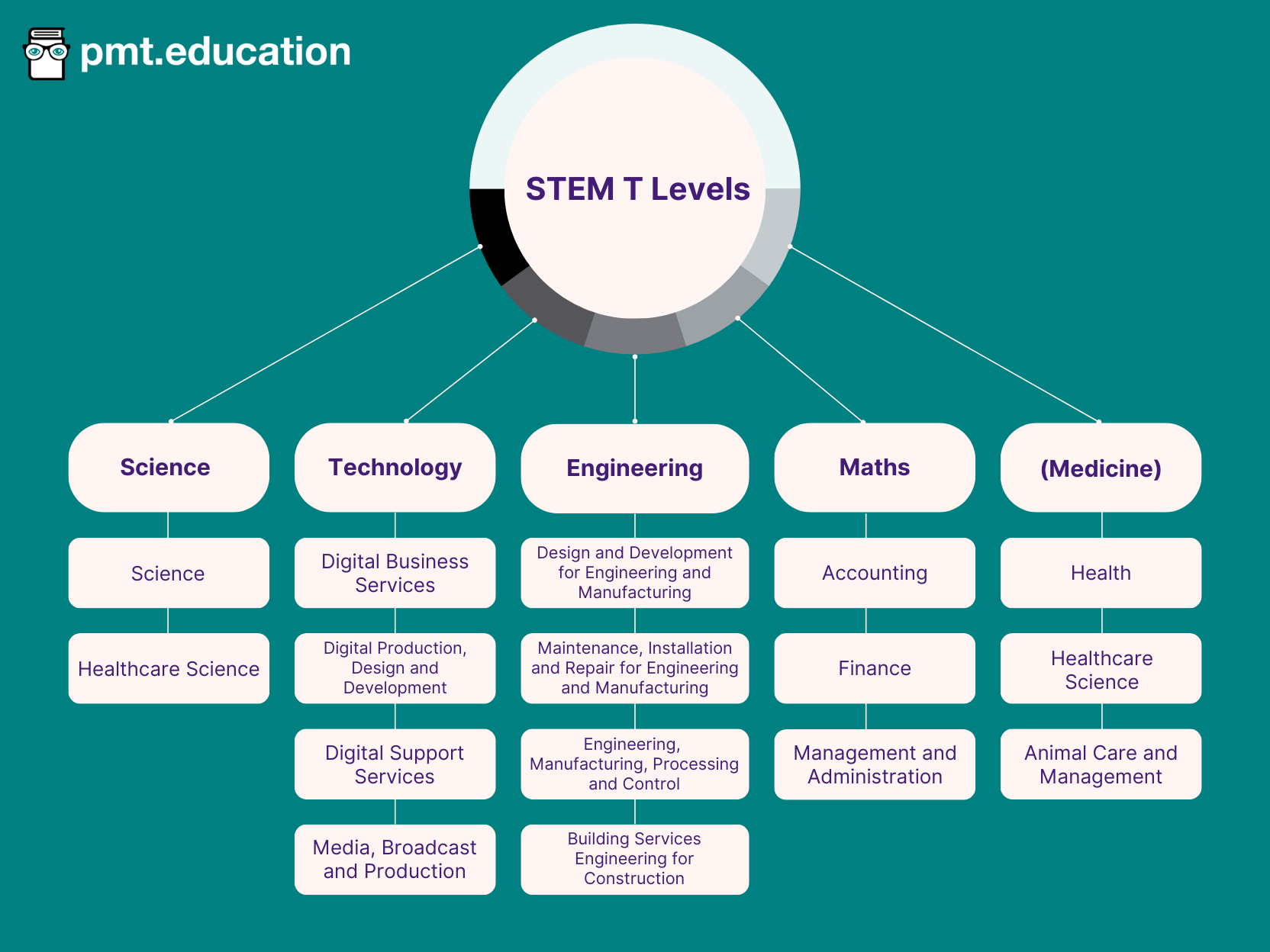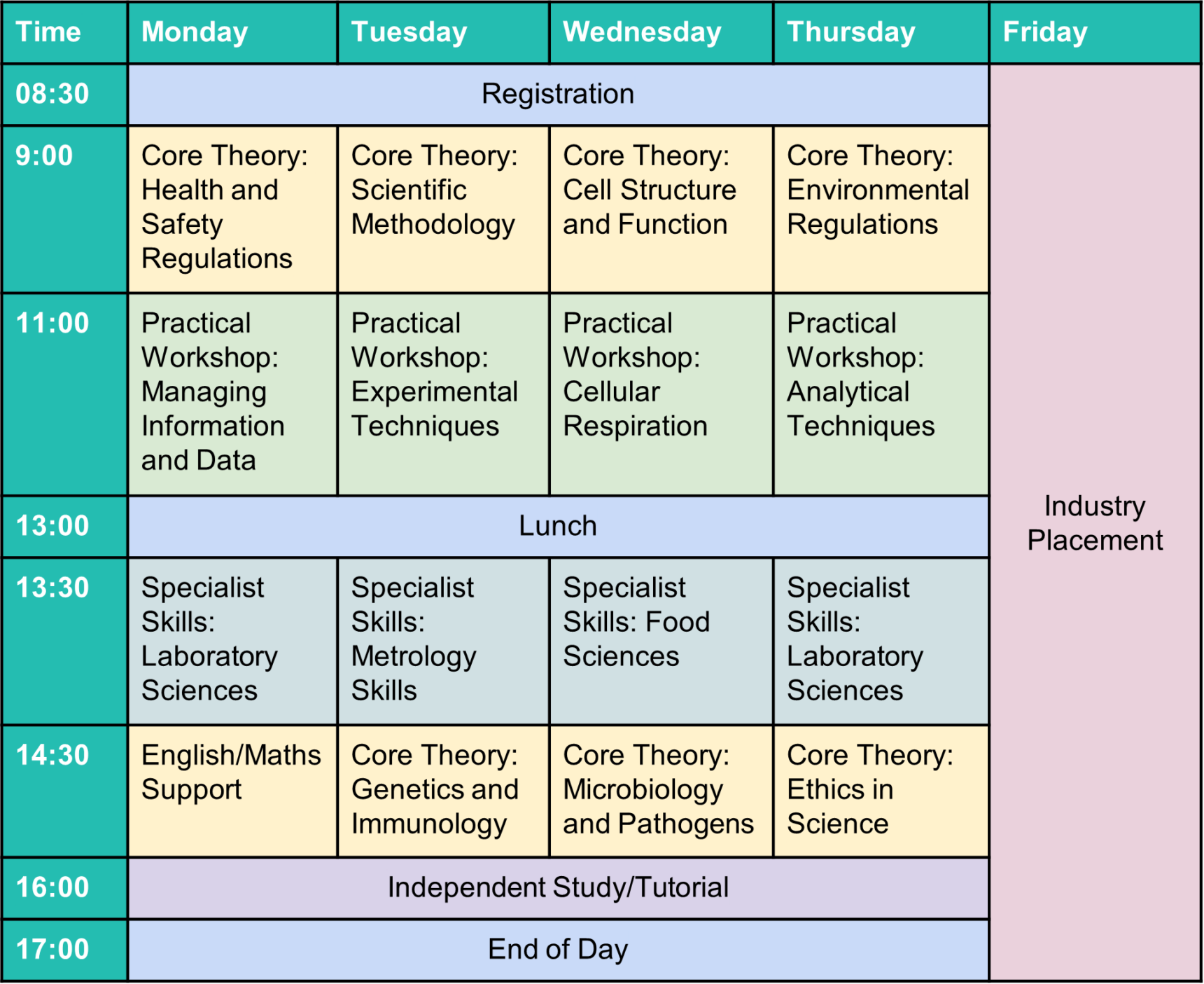Contents:
Qualification Level: Level 3
Age Group: 16-19 years
Cost: Free in state schools
Skills Developed: Technical skills + theoretical knowledge
Learning Environment: 80% classroom-based, 20% industry placement (45 days)
What are T Levels?
T Levels, or Technical Levels, are vocational courses designed for 16 to 19-year-olds in the UK, equivalent to 3 A Levels. Introduced in 2020, T Levels combine theoretical knowledge with practical industry experience, including a 45-day placement with an employer. If you’re interested in the practical aspects of STEM or prefer hands-on learning, a STEM T Level could be a good fit.
Why are T Levels being introduced?
The government introduced T Levels to simplify post-GCSE education options and improve the quality of alternative education pathways. With over 12,000 vocational qualifications available, T Levels are intended to replace less effective courses and provide clearer, more reliable pathways.
Another goal of T Levels is to increase the number of students pursuing vocational training and apprenticeships, offering a clearer path to employment. By offering a robust alternative to traditional routes like A Levels, T Levels aim to better align students with industry needs and enhance the UK’s workforce.
What T Level courses are available within STEM?
From September 2024, there will be 21 T Levels available, with two more added in September 2025. STEM subjects are well represented among these and below we’ve compiled a list of STEM T Levels that are available:

How do T Levels work?
Many respected further education institutions have confirmed they will accept T Levels for entry onto at least one of their courses. As the qualification gains momentum, it is likely that more institutions will join this list, further expanding opportunities for T Level graduates.
What is the course structure of a T Level?
T Levels are split into 80% classroom learning at your school or college and 20% industry placement. The classroom component forms the basis of the Technical Qualification (TQ) you’ll earn, while the 45-day industry placement offers practical experience and networking opportunities. Approved by the Institute for Apprenticeships and Technical Education, T Levels were developed with input from employers, industry experts, and educators, ensuring you receive top-quality training.
The Technical Qualification (TQ)
All students on a T Level course begin with the same core units, covering essential theories, concepts, and skills relevant to the chosen industry. Once you’ve built a solid foundation with these modules, you can choose one or more occupational specialisms to explore in greater depth. This is your chance to focus on areas that truly excite you.
“Classroom-based learning” isn’t just about sitting at a desk. Depending on your course, you might spend time in a lab or workshop. Practical learning and technical skills are just as important as theory in T Levels.
T Levels are often more content-heavy than BTECs and other vocational qualifications due to the rigorous curriculums and numerous contact hours. So, expect a busy, interactive, and engaging timetable. English, maths, and digital skills are a key part of the classroom-based element. If you haven’t achieved a grade 4 or above in English and Maths at GCSE, you’ll work towards these qualifications during your studies.

How does the industry placement in a T Level work?
One of the main draws of the T Level programme is the industry placement. This placement runs for a minimum of 315 hours, or 45 days. If your employer can’t offer the full duration, they can share the responsibility with another employer. Your provider will work with both to ensure your progress and education aren’t compromised. Depending on your course and placement, you might go to work on day release, in a block of days or weeks, or in a series of blocks.
You’ll be assigned to a local company within your sector of study. While your course provider is responsible for finding a suitable placement, you can also seek out your own if you have a specific role or company in mind. Ideally, your placement should align with your chosen specialism.
T Level placements differ from traditional work experience due to their length and depth. The minimum 45 days is much longer than other placements, such as the two weeks for some BTECs. During this time, you’ll engage in meaningful work rather than mundane tasks like fetching coffees or making photocopies! Your employer is expected to actively support your development and provide a valuable learning experience.
Unlike apprenticeships, T Level placements are part of an educational course, so employers aren’t obliged to pay you a wage, although some may choose to do so. Even without guaranteed payment, these placements can lead to great opportunities, such as job offers after graduation or strong references from managers and employers. Your employer or course provider might also offer expenses or subsidies for costs like food and travel.
A week in the life of a STEM T Level student
Below is a typical timetable for a STEM T Level student. The industry placement occurs on one day per week, aligning with the 80% classroom-based learning and 20% industry placement structure. For this example, the T Level is in Science.

How are T Levels graded?
Only the core and occupational specialism units are graded in your course. The industry placement and other course elements just need to be completed for certification. You’ll receive separate grades for the core component and each occupational specialism. The core component is graded from A* to E, like A Levels, while the specialisms are graded as Pass, Merit, or Distinction, similar to BTECs.
Your overall grade is a combination of these individual marks, resulting in a Pass, Merit, Distinction, or Distinction* (the latter is awarded if you achieve a Distinction in the specialism and an A* in the core). This final grade, along with the individual component grades, will be displayed on your nationally–recognised certificate. This certificate will also confirm your completion of the placement and any additional course requirements. Additionally, it will detail any English, maths, and digital qualifications you have earned, which are valuable for future applications.
Your units will be marked according to specifications set by the Awarding Organisation (AO). Your scores and those of your cohort will be graded using algorithms and weighted by module size to ensure fairness.
Assessments can occur at any time of year, not just during a summer exam period. Assessment methods will vary depending on your course, but will typically include:
- Coursework
- Written exams
- Practical projects
- Group work
- Portfolios
If you don’t pass your T Level, you’ll receive a “statement of achievement” listing the elements you did complete. This will credit you for the work and experience you gained.
For specific details on your course’s assessments, check with your course provider.
What is the T Level Transition Programme?
If you don’t meet the entry requirements for a T Level or want additional preparation, the T Level Transition Programme is here to help. This one-year course bridges the gap between GCSEs and T Levels, getting you ready for the challenges ahead.
In the Transition Programme, you will:
- Develop industry-specific technical skills
- Improve study, workplace, and digital skills
- Build a strong work ethic
You will also have opportunities to meet employers, visit workplaces, and potentially participate in mentorship or job shadowing experiences. These activities provide insight into what your future placement might entail and help prepare you for the T Level.
You might consider the Transition Programme if you:
- Need extra qualifications to apply for a T Level
- Want to boost digital skills
- Need to improve study habits and work ethic
- Are exploring different T Level options
- Prefer a classroom-based learning approach
- Want more time to prepare for a T Level
Some of the same organisations that offer T Levels also run Transition Programmes, and ideally, you’ll remain with the same provider for both. If this isn’t possible, consult with your current school or local providers for options. Be sure to check out the government’s list of approved T Level providers for more information.
Even if you’re unsure of which T Level to take, you can enrol in the Transition Programme with a general idea of your sector interest. The goal is to give you the tools and confidence to succeed in your T Level and beyond.
Are T Levels well recognised?
T Levels, designed by employers and approved by the Institute for Apprenticeships and Technical Education, are created with both employment and further education in mind. The work experience you gain can lead to skilled employment, higher-level vocational qualifications (like higher or degree apprenticeships), or professional development programmes. At the same time, the foundational knowledge and theory you acquire can also set you up for more traditional academic routes.
Do employers recognise T Levels?
If you’re considering a T Level, you might be wondering if employers value them. The good news is that many do. T Levels are designed to combine classroom learning with hands-on industry experience, ensuring you gain both theoretical knowledge and practical skills. This practical approach is highly appreciated by many employers, as it often means you are job-ready upon completion.
That said, recognition can vary from one employer to another. Some companies are already on board and actively seeking T Level graduates, while others might still be catching up. However, more businesses are beginning to recognise the value of T Levels, making it a promising path if you aim to stand out in the job market.

Do universities accept T Levels?
Yes, T Levels can be used to apply for university, but there are important considerations including the reputability of the T Level course and flexibility of university admissions.
T Levels are still relatively new, and not all universities and courses are accepting them as entry requirements. Even if you have enough UCAS points, some universities might still request A Levels or additional qualifications. As T Levels gain traction and their recognition expands, more universities are expected to accept them. In the meantime, while many institutions have confirmed acceptance of T Levels for at least some courses, your options might be more limited compared to A Levels.
UCAS tariff points have been assigned to T Levels:
| UCAS Tariff points | T Level overall grade | A Level equivalent |
|---|---|---|
| 168 | Distinction* | A*A*A* |
| 144 | Distinction | AAA |
| 120 | Merit | BBB |
| 96 | Pass (C or above on the core) | CCC |
| 72 | Pass (D or E on the core) | DDD |
According to UCAS, 510 T Level students applied to higher education in 2022, and nearly all received at least one offer. By the end of the year, 80% of these students had secured a place on a course, compared to 84% of A Level students. However, given that this is early data and the sample size is relatively small, these figures should be interpreted with caution.
T Levels are a valid pathway to further education, but it’s a good idea to check the specific entry requirements for any courses you’re interested in. Some universities or programmes might have stricter rules about which Level 3 qualifications they accept and what subjects you need to have studied, especially in STEM areas.
For certain courses like veterinary or medical science, you might need more than just good grades. Requirements could include specific work experience or passing tests like the UCAT. So, make sure you research your chosen degree thoroughly to know exactly what you need to prepare.
The 2023 Ofsted report on T Levels provides a more detailed examination of students’ experiences as they transition to higher education after completing their T Levels.
How do I apply for T Levels?
Applying for T Levels is similar to applying for A Levels since T Levels are available to students finishing their GCSEs. If your school offers T Levels, you should follow their application process for post-16 options. If you’re unsure how this works, talk to your tutor, teacher, or careers advisor for assistance.
Switching schools
If you need to switch schools or colleges, you’ll have to find out the application process for the new institution. To make an informed decision, attend open days at local sixth forms and colleges that offer T Levels. This will give you a better idea of which institutions fit your needs and preferences.
The application process generally involves filling out an online form where you’ll input your GCSE results and select your preferred T Level options. You’ll submit this form directly to the school or college you’re applying to. Most T Level providers have the necessary application form and details on their website, and you might need to rank your preferences in case certain courses are oversubscribed.
To locate nearby institutions offering T Levels and find out what specific courses they offer, use the government’s Find a T Level search tool.

Entry requirements for T Levels
Entry requirements for T Levels can vary by course and provider as the government does not set specific criteria. Generally, T Levels have lower entry requirements compared to A Levels. The intention is that all students will complete the course with at least a pass in GCSE Maths and English, as these subjects are included in the T Level curriculum. However, some providers may still require a minimum grade, such as a 4 in English and maths.
It’s a good idea to check the specific entry requirements with the school or college you’re interested in. If you don’t meet their requirements, consider discussing your situation with them, as they may be willing to make exceptions.
Factors to consider when choosing your T Level provider and course
- Timetabling – How are the mandatory contact hours divided up across the week/month/year? How much time will you spend in an actual classroom compared to a workshop or lab? Is the industry placement completed in one go, or on a day release basis?
- Industry placement opportunities – Does the provider have experience in finding placements for students? Have they got placements already lined up? If not, are you comfortable with the uncertainty of not knowing the specifics of your placement until closer to the time?
- Specialism – What options are there for specialism units?
- Connections – Are there strong links with local businesses and employers who can offer work placements?
- Experience – Has the school or college seen several cohorts through the course already, or is this their first time offering this qualification? As T Levels are fairly new, providers won’t have a lot of experience in T Levels specifically, but you can look into their experience with other vocational qualifications, such as BTECs.
- Reputation – How have they performed in terms of getting students into higher education or employment?
- Transition Programme – Do they also offer a Transition Programme for your course, if needed?
- English, maths, and digital skills – How do they approach this part of the course?
T Levels vs A Levels: Which is better?
When you’re trying to decide between T Levels and A Levels, it really comes down to your career goals and how you prefer to learn.
T Levels, which started in 2020, are all about getting hands-on experience in a specific field and combine classroom learning with a significant industry placement. If you’re eager to jump into a specific job or industry right after school, T Levels are designed to give you practical skills and real-world experience.
A Levels, on the other hand, have been a traditional choice for a long time and are ideal if you’re aiming for university. They allow you to study a few subjects in depth over two years, providing a solid academic foundation.
If you’re more interested in starting a career straight away and prefer learning through practical experience, T Levels could be a better fit. They’re great for those looking to enter specific fields including those in STEM. But if university is on your horizon and you want a strong academic base, A Levels might be the way to go.
Ultimately, think about where you see yourself in the future and what type of learning suits you best. T Levels focus on practical skills and industry exposure, while A Levels emphasise academic study. Both paths have their own advantages, so consider your career ambitions and learning style to make the best choice for you.
Are T Levels harder than A Levels?
Both T Levels and A Levels have their own challenges. A Levels tend to be more academically demanding, requiring a deep understanding of subject material assessed through rigorous final exams. T Levels, on the other hand, demand a broader range of skills, combining both practical and written assessments throughout the two-year programme.
T Levels vs other vocational qualifications
T Levels, BTECs, Apprenticeships, and NVQs are all vocational qualifications that involve dividing time between a training provider and a workplace. They focus on teaching specific skills, trades, or jobs while supporting your education. But what sets them apart? Fortunately, we have an article to help you easily understand and navigate these various vocational alternatives to A Levels.
Disadvantages of T Levels
You may have come across some discussion and controversy regarding the introduction of T Levels. Some teachers and politicians have expressed concerns, such as issues with accessibility in rural areas and the fact that marking is limited to a single awarding organisation. Let’s examine the 2023 Ofsted report to determine whether these concerns warrant your attention.
Issue 1: Arranging industrial placements
Some providers struggled to secure enough high-quality placements, especially in rural areas or industries with limited local presence. The quality and relevance of these placements varied, and some students didn’t get the full benefits intended. Additionally, employers often lacked proper information about T Levels, which impacted the effectiveness of the placements.
Issue 2: Student outcomes
Most students who completed the programme earned their qualification and felt ready for their next steps. However, there was a high dropout rate, and few progressed to the second year. Graduates typically went on to jobs, apprenticeships, or further study, but some struggled with getting accepted into universities with their T Levels.

Issue 3: Student experience
Student experiences with T Levels varied greatly. In the best cases, T Levels offered a strong blend of theoretical and practical education. However, some students felt they had been misled about the course content and structure.
Issue 4: Initial assessment
Initial assessments of students’ abilities were often weak. Many teachers struggled to effectively identify gaps in students’ knowledge, which affected how the curriculum was planned and how well students progressed.
What can you do to minimise the impact of these issues with T Levels?
- Choose institutions with experience in T Levels or similar vocational courses. Beyond course structures and curriculums, the key is their ability to teach practical skills and offer facilities like workshops or laboratories.
- Ensure you have an industry placement arranged. With the challenges of starting a new course, you don’t want the added stress of missing your mandatory 45 days of work experience. Your learning provider should have the connections and relationships with local employers to support you throughout your T Level.
- Talk to T Level graduates and read student testimonials, both on the T Level website and student forums like The Student Room, to get first-hand advice.
Despite these issues, there have also been notable successes with the T Level programme. A total of 90.5% of completers achieved a pass or higher, with many students successfully transitioning to employment or further education. Additionally, most students who remained in the programme reported feeling well-prepared for their next steps.
As with any new course, it’s expected that some issues will arise. Once all T Levels are fully rolled out in 2025, they should hopefully settle into a more stable form. In the meantime, it’s up to you to decide if you want to dive into this exciting new course while it’s still evolving.
FAQs
When were T Levels introduced?
T Levels were introduced in September 2020 in England. They were designed as a new qualification to provide students with a more technical and vocational route into work or further education.
What is the equivalent of T Levels?
T Levels are designed to be equivalent to A Levels in terms of UCAS points and academic rigour. They aim to offer you a practical and technical alternative to the more traditional academic qualifications.
How many A Levels is a T Level worth?
A T Level is equivalent to approximately three A Levels in terms of its academic value and the amount of study required. It is a two-year course designed to provide you with in-depth knowledge and practical experience in a specific industry.
How many T Levels can you take?
You can typically take one T Level at a time. The courses are designed to be comprehensive and involve substantial industry placement.
Can I take an A Level alongside a T Level?
The government supports students who want to take both A Levels and T Levels and encourages schools to do the same. It’s important to discuss this with a careers advisor to ensure you can manage both qualifications effectively. This combination is particularly appealing to STEM students because of the depth of technical knowledge involved in most STEM sectors.
Do you get paid for T Levels?
No, you do not get paid for undertaking T Levels. However, T Levels include a substantial industry placement, which provides valuable work experience and may come with payments and/or expenses covered by the employer.
Do online T Levels exist?
As of now, T Levels are primarily delivered in a classroom setting with a significant component of on-site industry placement. There are no fully online T Levels, though some elements of the learning may be available online to complement in-person instruction.



Comments